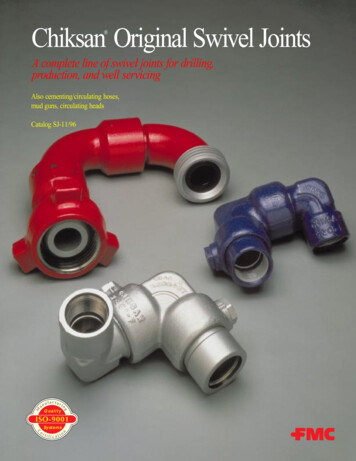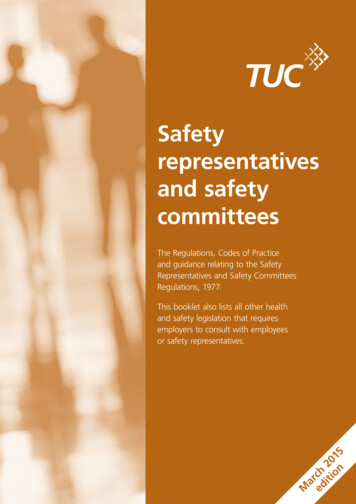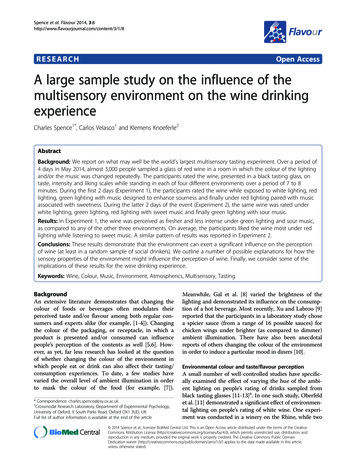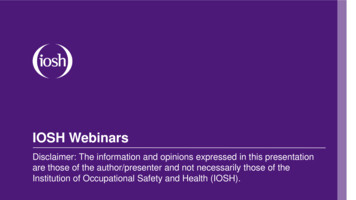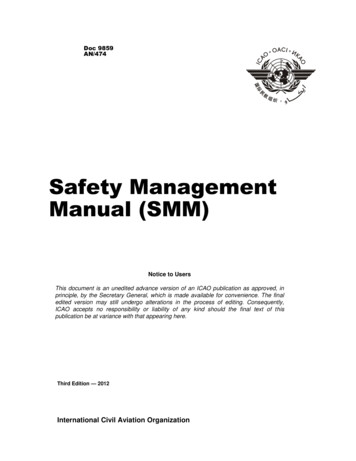
Transcription
Student Handout #1Your Safety IQ QuizSafetyWork together in your group to answer these questions. Guessing is OK. You won’t be gradedon your answers. Pick one person in your group to report your answers to the class later.ect answercorrectanswerer. Check the corr1. The law says your employer must give you training about health and safety hazards onyour job. True False Don’t know2. The law sets limits on how late you may work on a school night if you are under 16. True False Don’t know3. If you are 16 years old, you are allowed to drive a car on public streets as part of your job. True False Don’t know4. If you’re injured on the job, your employer must pay for your medical care. True False Don’t know5. How many teens get seriously injured on the job in the U.S.? One per day One per hour One every 10 minutes Don’t know
Student Handout #2Find the Hazards:Hazards:Fast FoodFastFood
Student Handout #3Find the Hazards:Hazards:Grocery StorGroceryStoree
Student Handout #4Find the Hazards:Hazards:Office
Student Handout #5Find the Hazards:Hazards:Gas Station
Student Handout #6Hunting for HazardsHazardsHazardKitchenOfficeOther Area ( )Possible Harm
Student Handout #7Page 1Info SearchSearchA. WorksheetYour team will be assigned one scenario to research from part C of this handout. Work withyour team to answer the questions below. Once all team members have completed theirresearch, discuss and agree on the answers you want to report to the rest of the class. Picksomeone in your team to make a brief report.1. What is the health and safety problem (hazard) in your scenario?2. What information might you be able to get at the workplace? Where would you get it?3. Pick three possible sources outside the workplace where you could get information. Thesemust include at least one government agency, and at least one organization or agency that isnot part of the government. You can search the internet, or request information by phone. Afew suggested resources are listed in part B of this handout. However, you do not need tolimit yourself to these. Each team member can get information from a different source, oryou can work together. Use these sources to answer the following questions.Short-term health effects. How could this hazard affect your body right away?InformationSource
Student Handout #7Page 2Long-term health effects. How could this hazard affect your body over time?InformationSourceSolutions. What are some possible ways to reduce or eliminate workers’ exposure to thishazard?InformationSource4. What was the most important information you learned, and why was it important?5. Which information source did your team find most useful, and why?
Student Handout #7Page 3B. Resources: Whero Get InformationResources:Wheree TToHere are some websites and phone numbers to get factsheets and other information on healthand safety hazards.Government AgenciesNew Jersey Occupational Health ServicesWebsite contains “Right To Know—Hazardous Substance Fact Sheets” for over kweb/rtkhsfs.htmNIOSH (National Institute for Occupational Safety and Health)Conducts research on hazards and has free publications on chemicals, ergonomics,child labor, and other /youth (Young Worker Safety and Health)1-800-CDC-INFO (1-800-232-4636)OSHA (U.S. Occupational Safety and Health Administration)Develops and enforces federal regulations and standards. Offers free publications and avideo library.www.osha.gov/SLTC/(800) 321-OSHAOther OrganizationsAFL-CIO Safety and Health on the JobBasic health and safety information, including an alphabetical listing of direct links tofact sheets developed by unions and OSHA. Some are available in infofs.cfm
Student Handout #7Page 4Labor Occupational Health Program (LOHP), University of California, BerkeleyTrains workers, unions, joint labor-management committees, and others on health andsafety. Sells publications and videos. Offers assistance and referrals on young workers,workplace violence, hazardous waste, ergonomics, and more.www.lohp.org(510) 642-5507NYCOSH (New York Committee for Occupational Safety and Health)Website has internet links and resources on health and safety by industry and topic, aswell as basic information on health and safety rights on the job.www.nycosh.org/Vermont SIRI (Safety Information Resources Inc.)Website contains links to many health and safety resources. Specializes in MaterialSafety Data Sheets.www.siri.org
Student Handout #7Page 5C. ScenariosScenario A: Big Box FoodsKevin works in a warehouse. He’s seventeen years old. One day, when he was loading 40pound boxes onto a wooden pallet, he suddenly felt a sharp pain in his lower back. He hadto stay out of work for a week to recover, and his back still hurts sometimes. He is worriedabout re-injuring his back, and tries to be careful, but he wants to find out more about safelifting and other ways to prevent back injuries.Scenario B: Brian’s Computer StationBrian has been working for six months as an administrative assistant in a large office. He isthe newest employee in the office, and seems to have all the hand-me-down equipment. Hiskeyboard and mouse sit right on his desktop, along with his computer monitor. The lever toadjust the height of his chair doesn’t work any more. He works at his computer most of theday. He knows at least one person in the office who wears braces on her wrists becausethey are tender and painful, and who can no longer do a lot of things at home because hergrip is so weak. Brian doesn’t want to develop any problems like that, and wants to findout what he can do.Scenario C: Dangerous Paint StripperJessica has a summer job working for the city parks program. She has been using a cleanercalled “Graffiti Gone” to remove graffiti from the bathrooms. She has to take a lot ofbreaks, because the chemical makes her throat burn. It also makes her feel dizzy sometimes,especially when the bathrooms don’t have very many windows. On the label, she sees thatthe cleaner has methylene chloride in it. She feels like she’s managing to get the workdone, but she is worried about feeling dizzy. She wants to find out more about thischemical, what harm it can cause, and whether there are safer ways to do this work.Scenario D: Noise at WorkEdiberto is 18 years old, and has been working for a company that manufacturesprefabricated homes for about a year. He spends a lot of the work day using a power saw.His ears usually ring for awhile in the evening, but it seems to clear up by the morning. Heis a little worried about whether it’s damaging his hearing, but it’s not that different thanhow his ears feel after a rock concert. He wants to find some information on how muchnoise is bad for you, and what he can do.
Student Handout #7Page 6Scenario E: Needles in the Laundry StackSimone works as an aide in a nursing home. Her best friend’s cousin Julia works in thelaundry department. Simone has heard Julia complain about the medical staff, because usedhypodermic needles sometimes show up in the dirty laundry. Simone is worried aboutJulia, but also doesn’t think the medical staff could be that careless. She wants moreinformation on what can be done.Scenario F: Stop and ShopSarah works in a convenience store. She and the other employees take turns working theclosing shift. It makes her nervous to be at the store by herself late at night, but she knowsif she refuses the closing shifts, the owner will just look for someone else for the job. Shecarries mace in her purse, and the owner has told her to give up the cash in the cash registerif she is ever faced with a robber, but she wants to find out what else can be done so shewill feel safe.
Youth at Work Talking SafetyStudent Handout #8Disaster Blaster Game Board?You’rehome,safe andsound!Pouredwater on agrease fire.Go BACKthreespaces.?No number forpoison controlcenter. Go BACKone space.Clearlymarkedexits. BLASTahead onespace.Tornadowatch ineffect. GoBACK onespace.?Flashlightsand batteriesavailable in anemergency.BLAST aheadone space.Chemicalspill.Go BACKthree spaces.?Videocamerasinstalled.BLASTahead onespace.?Fluoutbreak.Go BACKthreespaces.?MSDSsheetsavailable.BLASTahead onespace.First Aid kitsavailable.BLASTahead onespace.?Blocked exit.Go BACKone space.?No fireextinguisher.Go BACKone space.LearnedCPR.BLASTahead onespace.Poweroutage.Go BACKone space.?Emergencyplan in place.BLASTahead onespace.Reported anemergency to911.BLAST aheadone space.?No firedrills. GoBACK onespace.Stayed calm inan emergency.BLAST aheadone space.Start
Student Handout #9 – Page 1Disaster Blaster Game CardsQ.If you are inside abuilding and begin tofeel the shaking of anearthquake, whatshould you do?Q.If you are in a buildingand hear a tornadowarning, what shouldyou do?Q. If you smell smoke andsuspect a fire burningsomewhere in thebuilding, what shouldyou do?A.Get under somethingheavy or sturdy like adesk or doorframe.A.Go to the lowestlevel of the building;the basement, a stormshelter, or an interiorroom without windows.A. Alert others. Pull firealarm if available. Shutdoor and get out of thebuilding. Call 911 fromoutside.Q.If someone comes intoyour workplace with agun, what should youdo?Q.If an unknownchemical spills in yourworkplace, whatshould you do?Q. How many exit routesmust a workplace have?A.Cooperate fully withthe gunman’sinstructions, Don’ttry to be a hero.A.Leave it alone andget your supervisor.A.Enough to allow forsafe evacuation of allemployees (andcustomers) but at leasttwo exits.Q. True or False?If you are caught in afire you should stayclose to the ground.Q.What are the stepsfor using a fireextinguisher?Q.What phone numbershould you call toreport an emergency?A.P-A-S-S:Pull the pin;Aim the nozzle;Squeeze the trigger;Sweep extinguisherback and forth over thefire.A. 911.A.True.
Student Handout #9 – Page 2Q. What should you dofor a severe cut?Q.What should you dofor a very serioussecond or third degreeheat burn?Q.What should be usedto put out a greasefire on a stove?A.Apply pressure to thewound and, if thereare no broken bones,elevate the woundabove the heart.Seek medical help.A.Call 911. Don’t removeclothing if stuck to theburned area.A.A pan lid or bakingsoda. Never water orflour.Q.What should you doif you are in a buildingand the power goesout?Q. On the way home fromwork late one night,your car breaks downon an isolated road.What do you do?Q.You are working on aconstruction site and aco-worker enters atrench and passes out.What do you do?A.Stay calm. Ifappropriate to leave,look for lighted exitsigns. Otherwise, stay inplace and check withyour supervisor.A. Turn on hazard lights.Lock doors, stay in car.Call for help, wait forassistance. Or put signup asking passers- by tocall 911. Do not opencar to strangers.A.Tell a supervisor. Don’tgo after him; you maybecome a secondvictim. Call 911.Q.A co-worker slips ona wet floor, hits hishead, and losesconsciousness. What doyou do?Q.If a co-worker falls offa ladder and injures hisback, what should youdo?A.Don’t move him.Call 911. Checkbreathing andheartbeat. Give CPR ifyou can. Cover andkeep him warm.A.Don’t move him(this can cause moredamage).Call 911 for help.Q. If your clothes catch onfire, what should you do?A. Stop, drop, and roll;or smother the flameswith a blanket. Neverrun.
Student Handout #9 – Page 3Q.Name at least onefactor that increasesyour risk of beingrobbed at work?Q.What letters are onthe type of fireextinguisher that canbe used in any kindof fire?Q.What is thename of the sheetsthat provideinformation aboutchemical products?A.Working alone;working at night;access to money.A.A–B–C.(A) Trash, wood, paper;(B) Liquids, gasses,solvents;(C) Electricalequipment.A.Material Safety DataSheets—MSDSs.Q.What is at least oneitem that should beincluded in anemergency kit?Q.What does the skulland crossbones symbolmean?Q.If a chemical gets intoyour eye, what shouldyou do?A.Water; flashlight andbatteries; first aidsupplies.A.Poison.A.Flush it with water forat least 15 minutes.Q.Name one securitymeasure that canreduce workplaceviolence in a retailstore?Q.How do you preventthe spread of fluviruses?Q.What two commoncleaning productsshould you never mix,because they make agas that can kill you?A.Good lighting; a panicbutton or othercommunication device;a security guard; avideo camera.A.Cover nose / mouthwith a tissue whencoughing / sneezing.Wash hands, don’ttouch eyes, nose, ormouth. Stay home.A.Ammonia and bleach(the mixture releaseschlorine gas, whichcan be deadly).
Student Handout #9 – Page 4Q.Q.If you are driving towork and see thefunnel shape of atornado approaching,what should you do?Q.If you are workingoutside when alightning storm startsand you can’t get toshelter, what shouldyou do?A. Watch: Severe weatherpossible during thenext few hours.Warning: Severeweather observed orexpected soon.A.Get out of the car andlie down in a lowplace.A.Crouch low to theground, sit on theballs of your feet, stayaway from trees andmetal objects.Q. What do you do if youcome in contact with asubstance, but don’tknow whether or not itis toxic?Q.What can you use tomelt ice on thesidewalks in the winter?Q.Name at least twothings that should bein an EmergencyAction Plan.A.A.Rock saltA.Name of person whois in charge; escaperoutes; training; drills;alarm systems;meeting place.Q.Is it safe to use a cellphone or cordlessphone during a storm?Q.If a co-worker suffersfrom heat exhaustion,what should you do?A. Yes. These are safe touse because there is nodirect path betweenyou and the lightning.Use a cordedtelephone only in anemergency.A.Get the person out ofthe sun. Give her coolwater. Lay the persondown and elevate herfeet. Call 911.What’s the differencebetween a weatherwatch and a weatherwarning?Call the NationalPoison Control Center:1-800-222-1222.Q. What does CPR standfor and what is it?A.CardiopulmonaryResuscitation. CPR is acombination of rescuebreathing and chestcompressions for avictim whose heart hasstopped beating.
Student Handout ##110Page 1Emergencies in the NewsEmergenciesIn your small group, read your assigned news story, then answer the three questions on the otherside.Story A: Grease Fire in Restaurant Burns EmployeeA fire erupted at Sunny’s Family Restaurant Tuesday night, critically injuring an employeeand causing 100,000 worth of damage to the building. The fire was caused when a fryingpan, filled with oil heating up on the stove, was left unattended. The fire rapidly spread todish towels hanging nearby. An employee discovered the scene and attempted to put outthe fire by pouring water on the stove, causing the burning grease to splatter all over hisface, arms, and chest. A co-worker, hearing the commotion, called 911 and yelled foreveryone to leave the restaurant immediately. The fire department arrived, extinguished thefire, and attended to the burned employee. The victim was taken to Mercy Hospital and isreported to be in serious but stable condition.Story B: Robber Threatens Young Employee With GunA 16-year-old employee of a local convenience store was held up at gunpoint lateThursday night by a masked man demanding money. The employee was working aloneand in the process of closing the store for the evening. The employee later reported topolice that, after emptying the cash register, the robber tied him up and then left with themoney. Although the young employee was shaken up by the incident, he was notphysically injured. The name of the young employee is being withheld because of his age.Story C: Parents Praise Quick Action of Local TeenParents Charlene Cook and Kelly Nelson, who have children attending the Happy GoLucky Day Care Center, called the Daily Times this week to praise the quick action of17-year-old Tamara Thompson, one of Happy Go Lucky’s star employees. Tamara noticedthat an entire container of bleach had spilled near the janitor’s closet and was giving offfumes in one of the nearby classrooms. Knowing that some of the children have asthma,Tamara walked the children to another teacher’s classroom so they wouldn’t be exposed.She then rushed back with paper towels to clean up the spill. Unfortunately, Tamara herselfsuffered breathing problems after cleaning up the bleach and had to be taken to theemergency room to be checked. She is currently at home recovering but plans to return towork when she feels better.
Student Handout ##110Page 2Story D: Young Construction Worker Falls From LadderAn 18-year-old house painter, who was painting the second story of a house, fell off hisladder yesterday, breaking both legs. He also suffered severe cuts when he caught his armon a metal fence during the fall. Co-workers rushed to assist him and called for anambulance. Local EMTs reported that the co-workers carried the fallen employee to thefront lawn and then applied pressure to the open wound to stop the bleeding.Story E: 6.1 Earthquake Shakes Local High Rise Office BuildingOffice workers at R&D Business Solutions huddled under desks and doorways as a 6.1earthquake shook their building. Once the tremors subsided, they followed lighted exitsigns to the stairwell. They made it down ten flights of stairs and outside to the street.Gladys Royce, of Washington Township, whose son, Jason, is an employee of thecompany, complained that her son, who has Down Syndrome, was left alone to figure outwhat to do during and after the earthquake. The employees and supervisors had no ideaJason had remained on the 11th floor. The company pledges to take another look at itsEmergency Action Plan and make sure the plan protects and prepares all their employees,including those who may need extra assistance.Story F: Tornado Breaks Windows at Local Department StoreA tornado blew through town yesterday, causing major power outages and damage toseveral buildings, including blowing out most of the windows in Johnson’s DepartmentStore on East 8th Street. As glass went flying, employees reportedly herded customers intothe center section of each floor in the three-story building. Customer Tom Wilson expressedappreciation for the assistance employees provided in getting everyone away from thewindows.Questions1. What went right in this situation?2. What went wrong in this situation?3. What steps should be taken in this workplace to make sure employees are better protectedand prepared the next time?
Student Handout #11Emergency Action PlansEmergencyPlanning ahead can reduce the effects of an emergency on workers, the workplace property, andthe surrounding community. In preparing an Emergency Action Plan, an employer can figure outwhat protections are needed and what procedures should be followed in an emergency. Allworkplaces should have an Emergency Action Plan.An Emergency Action Plan should be in writing. It should state who is responsible forcoordinating emergency response; where chemicals are stored and where Material Safety DataSheets ( MSDSs) for these chemicals are kept; and how critical operations will be maintainedduring and after an emergency (if necessary). The plan should also list measures that will be takento protect employees (including those with physical disabilities).Training and drillsThere should be training and regular practice drills so everyone knows what to do duringdifferent kinds of emergencies. Workers should be trained so they understand theirresponsibilities during an emergency; the alarm system and “all clear” announcements; whereto gather during an emergency; how to report an emergency; what to do if there is a chemicalspill; and when and how to use emergency equipment.Alarm systemsThese must be seen, heard, and understood by all employees.Shelters and evacuationThe plan should designate inside shelters, exits, evacuation routes and procedures, and outsidemeeting places. Shelters inside the building should be identified if tornadoes or hurricanes are apossibility. Exits and evacuation routes should be checked periodically to be sure they are notblocked. Exits should be of sufficient number, width, and location that workers can rapidlyevacuate. An outside meeting place should be designated so employees can be counted afterevacuation.Emergency lightingExit routes should have emergency lighting in all areas where work is performed after daylighthours.Emergency equipmentThe plan should provide for installation and testing of appropriate emergency equipment suchas building sprinkler systems, fire extinguishers, eyewash systems, and safety showers ifchemicals are used.Procedures to follow when someone is injuredFirst aid kits should be provided, as well as trained personnel to use them. Employees shouldknow who is trained in first aid or CPR, and where to get medical attention if needed.
Student Handout #12 – Page 1Maine EditionAre You a Working Teen inMaine?Protect Your Health!Know Your Rights!Could I get hurt or sick on the job? 18-year-old Sylvia caught her hand in anelectric cabbage shredder at a fast foodrestaurant. Her hand is permanently disfiguredand she’ll never have full use of it again. 17-year-old Joe lost his life while working as aconstruction helper. An electric shock killedhim when he climbed a metal ladder to hand anelectric drill to another worker. 16-year-old Donna was assaulted and robbed atgunpoint at a sandwich shop. She was workingalone after 11 p.m.Every year in the United States, 158,000 teens underage 18 are injured in the workplace. Approximately53,000 young people seek emergency roomtreatment for their injuries. On average, 48 teens dieeach year from work-related injuries.Why do teens get sick or hurt on the job? Injuries toyoung workers are usually due to unsafe equipmentor a hazardous environment, stressful conditions, orworking too fast to meet a deadline. As a youngworker, you are more likely to be injured on jobsthat the law does not allow you to do.What hazards should I watch out for?Type of workExamples of hazardsFood ServiceSlippery floorsHot cooking equipmentSharp objectsRetail/SalesViolent crimesHarassmentHeavy liftingOffice/ClericalStressHarassmentPoor computer work station designJanitor/Clean-upToxic chemicals in cleaning productsBlood on discarded needlesFarm/AgriculturalUnsafe machineryChemicals in pesticidesSlippery surfaces and confined spaces
Student Handout #12 – Page 2Maine EditionWhat are my rights on the job? Report job discrimination without beingpunished or treated differently by youremployer.By law, your employer must provide: A safe and healthful workplace. Training on chemicals and other health andsafety hazards.Request reasonable workplace accommodationsfor religious beliefs or a medical condition. Refuse to work if the job is immediatelydangerous to your life or health. Join or organize a union. Protective clothing and equipment. (At least) the Maine minimum wage of 7.50 per hour. Some jobs are exempt fromminimum wage laws. For more details, seewww.dol.gov/whd/minwage/america.htm.H You have a right to engage in groupactivities to try to improve workingconditions, wages, and benefits.H You have a right to talk about your wagesWorkers’ compensation benefits if you arehurt on the job. These include: Medical care for your injury, whether ornot you miss time from work.with your co-workers.Is it ok to do any kind of work? Payments if you lose wages for more thanseven days.NO! Certain laws protect teens from doingdangerous work. Other benefits if you become permanentlydisabled.In Maine, no worker under age 18 may:You also have a right to: Report safety problems to OSHA. Work free of discrimination and harassmentbecause of your race, color, religion, sex(including pregnancy), national origin,disability, age (age 40 or older), or sexualorientation. Examples of workplace harassmentinclude: Lewd jokes, racial or ethnic slurs,pressure for sexual favors, unwelcomecomments about religion, or offensivepictures or graffiti. Drive a motor vehicle on public streets as partof the job (17-year-olds may drive in verylimited circumstances). Drive a forklift or other heavy equipment. Use powered equipment like a circular saw, boxcrusher, meat slicer, or bakery machine. Work in wrecking, demolition, excavation, orroofing. Work in logging or a sawmill. Handle, serve, or sell alcohol. Work where there is exposure to radiation.Also, no one 14 or 15 years old may: Do any baking activities.
Student Handout #12 – Page 3 Cook (except with electric or gas grills that donot involve cooking over an open flame andwith deep fat fryers that automatically lowerand raise the baskets). Work in dry cleaning or a commerciallaundry. Do building, construction, or manufacturingwork. Load or unload a truck, railroadcar, or conveyor. Work on a ladder or scaffold.Are there other things Ican’t do?YES! There are other restrictions on the type ofwork you can and cannot do. Age 14 is theminimum for most employment, except forinformal jobs like babysitting or yard work.Check with your state labor department, schoolcounselor, or job placement coordinator to makesure the job you are doing is allowed.Do I need a work permit?Maine Edition Report any health and safety hazard to yoursupervisor. Ask questions if you don’t understand.You have a right to speak up!By law, your employer cannot fire or punish youfor reporting a workplace problem or injury, orfor claiming workers’ compensation.Should I work this late or this long?Child labor laws protect teens from working toolong, too late, or too early.The table below shows the hours Maine teens maywork. (Some school districts may have morerestrictive regulations. Also, there are someexceptions for teens in work experience educationprograms).Work Hours for Maine TeensWork hoursYES! If you are under 16 and plan to work, youmust get a work permit from the MaineDepartment of Labor. If you are under age 18,your employer must have on file a copy of your“proof of age” (such as a birth certificate, driver’slicense, or work permit).What are my safety responsibilities onthe job?Ages 16 and 177am–7pm, from LaborDay to June 17am-10pm whenthere is school thenext dayWhen attendance atschool is not required7am–9pm, from June 1to Labor DayMaximum hourswhen school is insessionTo work safely you should: Ages 14 and 1518 hours a week, butnot more than:20 hours a weekbut not over:3 hours a day on schooldays4 hours a daySunday-Thursday8 hours a day Saturdayto Sunday, and holidays8 hours a dayFriday, Saturday, &holidaysFollow all safety rules and instructions; usesafety equipment and protective clothing whenneeded. Look out for co-workers. Keep work areas clean and neat. Know what to do in an emergency.5am-midnightwhen there is noschool the nextday6 days in a rowMaximum hourswhen school isnot in session40 hours a week50 hours a week8 hours a day10 hours a day6 days in a row6 days in a row
Student Handout #12 – Page 4What if I get hurt on the job?Tell your supervisor right away. If you’re under18, tell your parents or guardians, too. Getemergency medical treatment if needed. Request aclaim form from your employer, if he/she doesnot immediately provide one. Fill it out and returnit to your employer. This helps ensure that youreceive workers’ compensation benefits.Workers’ Compensation:Maine Edition Contact one of the following agenciesnecessary:To make a health or safety complaint: OSHA (Occupational Safety and HealthAdministration)(800) 321–OSHA (6742)www.osha.gov Did You Know?Public Sector Enforcement Program, MaineDepartment of Labor You can receive benefits: Even if you are under 18.To make a complaint about wages or workhours: Even if you are a temporary or part-timeworker (in most cases). You receive benefits no matter who was atfault for your job injury. You don’t have to be a legal resident of theU.S. to receive benefits. You can’t sue your employer for a job injury(in most cases).What if I have a safety problem? Talk to your supervisor, parents, teachers, jobtraining representative, or union representative(if any) about the problem. Contact NIOSH (National Institute forOccupational Safety and Health) for generalsafety information.(1–800) CDC–INFO (232–4636)www.cdc.gov/niosh (877) 723-3345www.maine.gov/labor/workplace safetyCall the National Young Worker SafetyResource Center for health and safetyinformation and advice. Many materials areavailable in Spanish.(510) 643–2424www.youngworkers.orgWage and Hour Division, Maine Department ofLabor(207) 623-7900www.maine.gov/labor/labor laws U.S. Department of Labor(866) 487–9243www.dol.gov/whd/HTo make a complaint about sexual harassmentor discrimination: Maine Human Rights Commission(207) 624-6050www.state.me.us/mhrc U.S. Equal Employment OpportunityCommission(800) 669–4000www.youth.eeoc.govFor information about benefits for injuredworkers: Maine Workers’ Compensation Board(888) 801-9087www.state.me.us/wcbThe information in this factsheet reflects your State and/or Federal labor laws as of 2010, whichever are more protective.The more protective laws usually apply. For current information, check with your state agencies listed in this handout.
Student Handout #13dLabor Law Bingo: BoarBoard#118 years old4 hours18 hoursBox crusher7 PMThe employer53,000 teens16 years oldMedicaltreatment an hourWage & HourMaineDivision,Human RightsMaineCommissionDepartmentof LaborFREESPACESPACESafe andhealthyworkplaceMaineDepartment ofLabor3 hoursDriving avehicleFollowsafety rulesLoad/unloadtrucks9 PMMidnight10 PM8 hoursNo7 AM
Student Handout #13dLabor Law Bingo: BoarBoard#28 hoursFollowsafety rules5 AM4 hours an hour18 hoursMaineHuman RightsCommissionThe employerFREESPACESPACE7 PMCookMedicaltreatmentOSHAFork Lift18 years old3 hoursMidnightWage & HourDivision,MaineDepartmentof LaborProtectiveequipment7 AM9 PM16 years oldMaineDepartment ofLaborRoofing10 PM
Student Handout #13dLabor Law Bingo: BoarBoardLost wages18 years oldFollowsafety rulesWage &
room without windows. Q. If you smell smoke and . suspect a fire burning somewhere in the building, what should you do? A. Alert others. Pull fire . alarm if available. Shut door and get out of the building. Call 911 from outside. Q. If someone comes into your workplace with a gun, w
